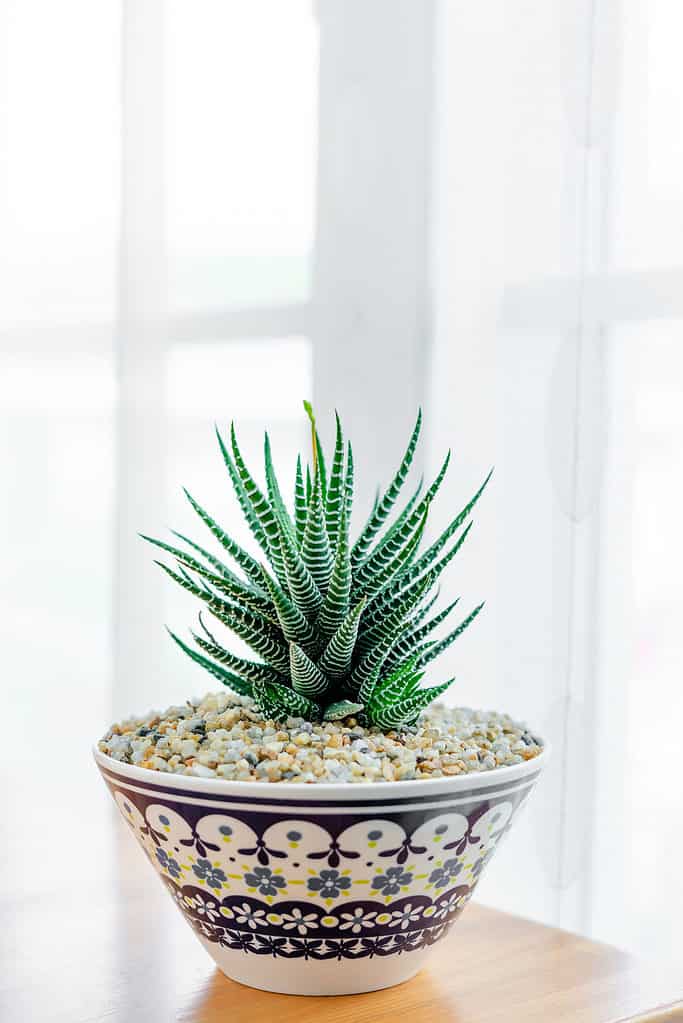When it comes to plants, do you have a green thumb or are you all thumbs? Either way, you’ll want to get to know the haworthia succulent! These perennial succulents are popular for both novice and veteran plant enthusiasts due to their extreme ease of care.
Part of the aloe family, haworthia is actually not one specific plant, but rather a large genus of small succulent plants, many of which are native to South Africa. A few species are endemic to bordering nations such as Mozambique and Namibia.

Native to southern Africa,
haworthiasucculents thrive in dry sunny conditions.
©iStock.com/Mirjana Mutic
These miniature succulents have different structures, depending on the variety. One of the more common structures includes rosette-like leaves which grow in clusters. Some varieties display light, nearly translucent leaves, while others are a much darker green. White pearly warts or bands often cover the darker green-leafed varieties. Those white spots can turn a reddish-purple when given proper sunlight.
Though there is a wide diversity among the 100+ haworthia species, most will thrive in the same easy-to-create growing conditions. Here’s what you need to know.
| Haworthia Facts | |
|---|---|
| Botanical name | Haworthia |
| Common Names | Pearl plant, star window plant, zebra cactus, cushion aloe |
| Sunlight | Partial to full sun |
| Soil | Sandy, well-drained |
| Water | Every 2-3 weeks |
| Indoors or Outdoors | Indoors with east or west-facing window access. Outdoors in Zones 10 and up. |
Sunlight
Typical of most succulent plants, haworthias need lots of sunlight. They do best, however, when shaded from the harshest afternoon sun as it can scorch the leaves. If the leaves turn red or yellow, the plant probably receives too much direct sun and needs a bit more shade. If the green leaves begin to fade in color, however, the plant is likely not receiving enough daily sunshine.
Soil Type
Haworthias thrive in well-draining soil. Prepackaged succulent or cactus potting mixes work well.
When creating your own mix, use two parts potting soil, two parts gravel, and one part perlite or horticultural pumice.
Drainage is key to a haworthia’s success. When choosing a container, make sure there are adequate drainage holes. Terracotta pots are effective at wicking away moisture from the soil, so they are a great choice.
These diminutive succulents only grow a few inches in height and width, so smaller pots can be used. Several plants can also be grown together in larger containers.
Water
Minimal watering is required. Once every 2-3 weeks is usually adequate, with even less water required in the winter. Make sure the top inch of soil is dry before watering to ensure that you don’t overwater, which can lead to root rot.
Placement
When growing indoors, make sure the plant has plenty of morning or evening sun. The plant easily tolerates average household temperatures and humidity. As long as it’s not placed in the direct sun of mid-afternoon, it should do just fine.
Haworthia succulents are a popular plant for outdoor gardens in warm climates. They are generally winter-tolerant in Zones 10 and above. If you live in a colder region, it’s best to plant them in containers that can be moved inside during colder weather. Remember, this succulent is native to southern Africa and cannot tolerate frost.
Haworthias are non-toxic, so they make ideal houseplants.

succulents are non-toxic and make great houseplants.
©iStock.com/artpritsadee
Propagation
The easiest and most popular way to propagate haworthia succulents is through replanting its often-produced offsets. Separate the offsets from the mother plant, using a sharp knife or shears. Leave as many roots as possible on the offset.
Once removed, allow the offset to airdry for 1-3 days and then replant the daughter plant in the same type of soil as the mother plant.
Haworthia succulents can also be propagated using cuttings. Cut a leaf from the mother plant and allow it to dry for 2-3 days. After drying, plant the cutting in the same soil type as the mother plant with the cutting side down. Keep it moist and warm until it takes root. You can then care for it in the same way as the mother plant.
It should be noted that working with cuttings is more difficult than offsets and carries a greater risk of failed propagation. Offsets are recommended to propagate these succulents, especially for beginners.
Common problems
Haworthias are among the least demanding plants you’ll ever encounter. There are relatively few problems common to these succulents.
If an issue does arise, it is likely a result of overwatering. Too much moisture in the soil prevents the exchange of gases in the roots and can lead to fatal root rot.
While the plant is not susceptible to many pests, it is vulnerable to the age-old enemy of most succulents: the mealybug. When only a few mealybugs are present, they can be washed away with water or removed by hand. For larger infestations, diluted neem oil is an effective solution. Neem oil can make the plant more vulnerable to sun scorching, so it’s best to treat it in the evening.
Spider mites, aphids, and gnats are less common, but can still be problematic. Neem oil or insecticidal soap can be used if any of these pests are present.

succulents are hardy little plants with relatively few problems.
©iStock.com/t sableaux
Don’t let these problems and issues dissuade you from haworthia succulents, though. They are quite tolerant and forgiving plants and are susceptible to comparatively few problems. These tiny succulents are a wonderful and super-easy addition to your botanical collection!
Up Next:
The photo featured at the top of this post is © iStock.com/WhiteLacePhotography
Thank you for reading! Have some feedback for us? Contact the AZ Animals editorial team.






